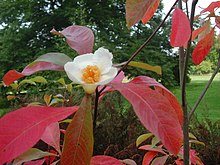
A glacial relict is a population of a species previously common during a glacial period that retreated into refugia during interglacial periods.[1] They are typically cold-adapted species with a distribution restricted to regions and microhabitats that allow them to survive despite climatic changes.[1][2]
- ^ a b Dítě, Daniel; Hájek, Michal; Svitková, Ivana; Košuthová, Alica; Šoltés, Rudolf; Kliment, Ján (September 2018). "Glacial-relict symptoms in the Western Carpathian flora". Folia Geobotanica. 53 (3): 277–300. doi:10.1007/s12224-018-9321-8.
- ^ Jiménez-Alfaro, Borja; García-Calvo, Laura; García, Pedro; Acebes, José Luis (2016). "Anticipating extinctions of glacial relict populations in mountain refugia". Biological Conservation. 201: 243–251. doi:10.1016/j.biocon.2016.07.015.